| One More Tied Unit Weave |
Marcy Petrini
February, 2022
I will be presenting a seminar titled “An Eight-Shaft Primer of Tied Unit Weaves” at Convergence®, so I have been weaving tied unit weave samples.
My original intent for proposing the seminar was to review what I knew and to learn a bit more. But I am finding that the more I learn, the more I discover there is to learn.
First, I wove summer and winter on 8-shafts with its many treadling options. Here is a sheep from Strickler’s book A Weaver’s Book of 8-Shaft Patterns from the Friends of Handwoven (pg. 148):
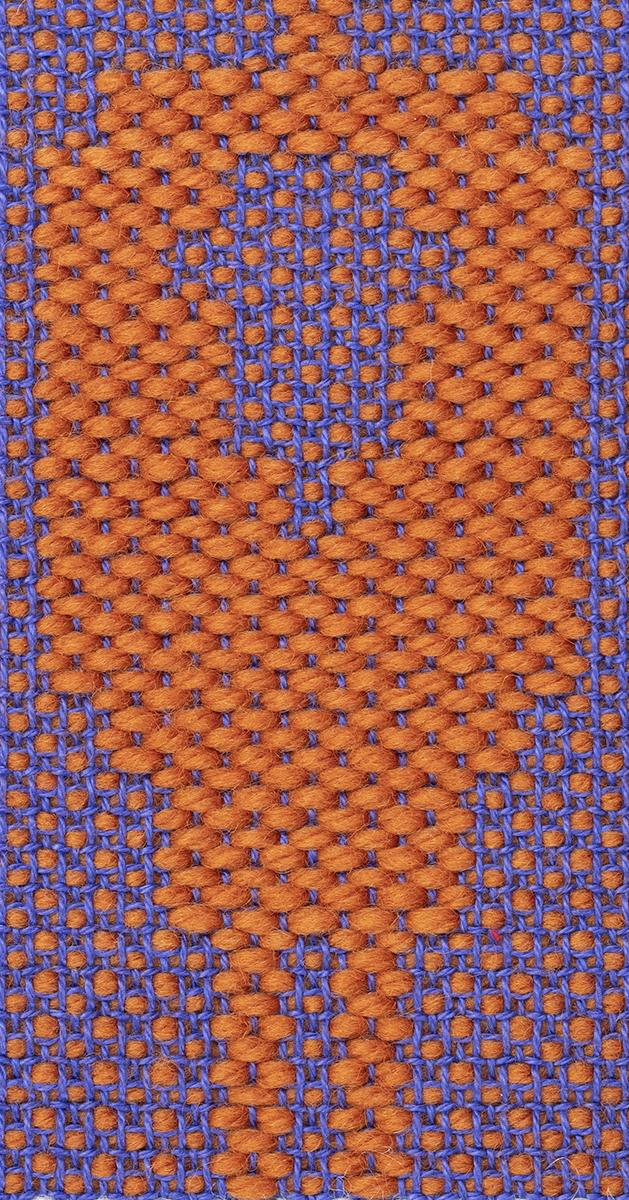
Next I went back to old favorites, for example Tied Lithuanian; then I tried structures I hadn’t woven before, for example half-satin.
Soon I realized how unhelpful those names are in understanding the structure. While Tied Lithuanian and Tied Latvian – different treadlings on the same threading – are at least descriptive of where they originated, half-satin is a deceptive name: satin is a simple weave by Emery’s classification, simple meaning one warp and one weft. tied unit weaves are compound structures, one warp, two wefts, specifically supplementary weaves, since the additional weft is not needed for the integrity of the cloth.
Some supplementary weft weaves, for example overshot, are inherently different from tied unit weaves; to differentiate them, Donna Sullivan in her book Summer and Winter, A Weave for All Seasons, uses the term supplementary weft patterning for tied unit weaves, because they generally form a characteristic stippled pattern, as seen in the sheep.
With this name confusion, I went back to Donna Sullivan’s classification which can be used for any number of shafts; using summer and winter as an example, here is how tied unit weaves can be described; unfortunately with more shafts, the nomenclature is not always unique:
|
Nomenclature |
Explanation |
Summer and Winter |
|
Single, double, etc. |
Number of pattern shafts per block |
One shaft of pattern per block, 3 for A, 4 for B, 5 for C, etc. |
|
# Tie shafts |
Number of shafts for the tie down threads |
Shafts 1 & 2 |
|
Paired or unpaired |
Whether the ties are next to each other (paired) or not |
Shafts 1 & 2 are separated by the pattern shaft |
|
Ratio |
Tie-down threads to pattern threads within a block |
For each tie down thread, there is a pattern thread |
Thus, summer and winter is a single, two tie, unpaired with a ratio of 1:1 structure. We can abbreviate to single, unpaired two-tie, 1:1.
Below is the drawdown, using sinking shed and showing only the pattern weft. In weaving we alternate each pattern shot with a plain weave shot, treadled 1 & 2 vs. 2 & 4. The reason for using a sinking shed is because we think of “weaving a block” as covering it with weft. When the warp lowers, the weft floats over it, making the connection between shafts and blocks easier to see.
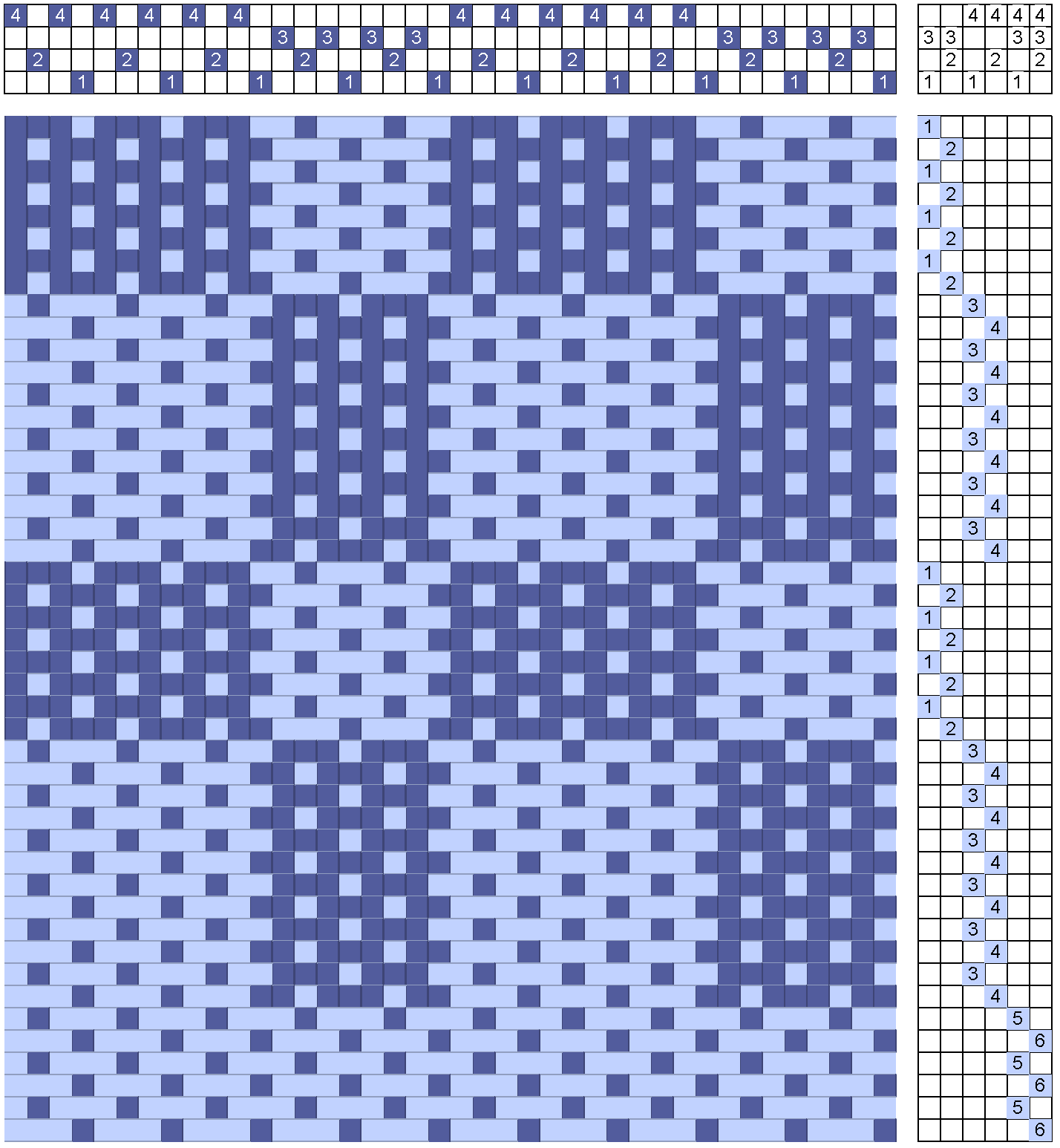
The drawdown shows the features of tied unit weaves. The first distinguishing characteristics is that the threading of each block is fixed, the ties limit the floats, so blocks can be repeated adjacently. In the above draft for summer and winter, block A is repeated 2 times, block B 3 times. When we look at the drawdown, the blocks are seamless, just different in size, but the weft floats are never longer than over three warp ends.
The second distinguishing characteristic, this shared with all unit weaves, is that blocks can be treadled together. This is shown at the bottom of the drawdown, but it is also seen in the sheep motif. This characteristic of combining blocks in treadling is a powerful design option, especially when we expand to more shafts, as seen in the sheep.
Bronson Lace is a unit weave, but not tied, even though at first glance, shaft 1, shared with all blocks, makes it appear that it is a tie. The drawdown below shows that shaft 1 acts as a tabby and the floats in the blocks are delimited by shaft 2, the other tabby.
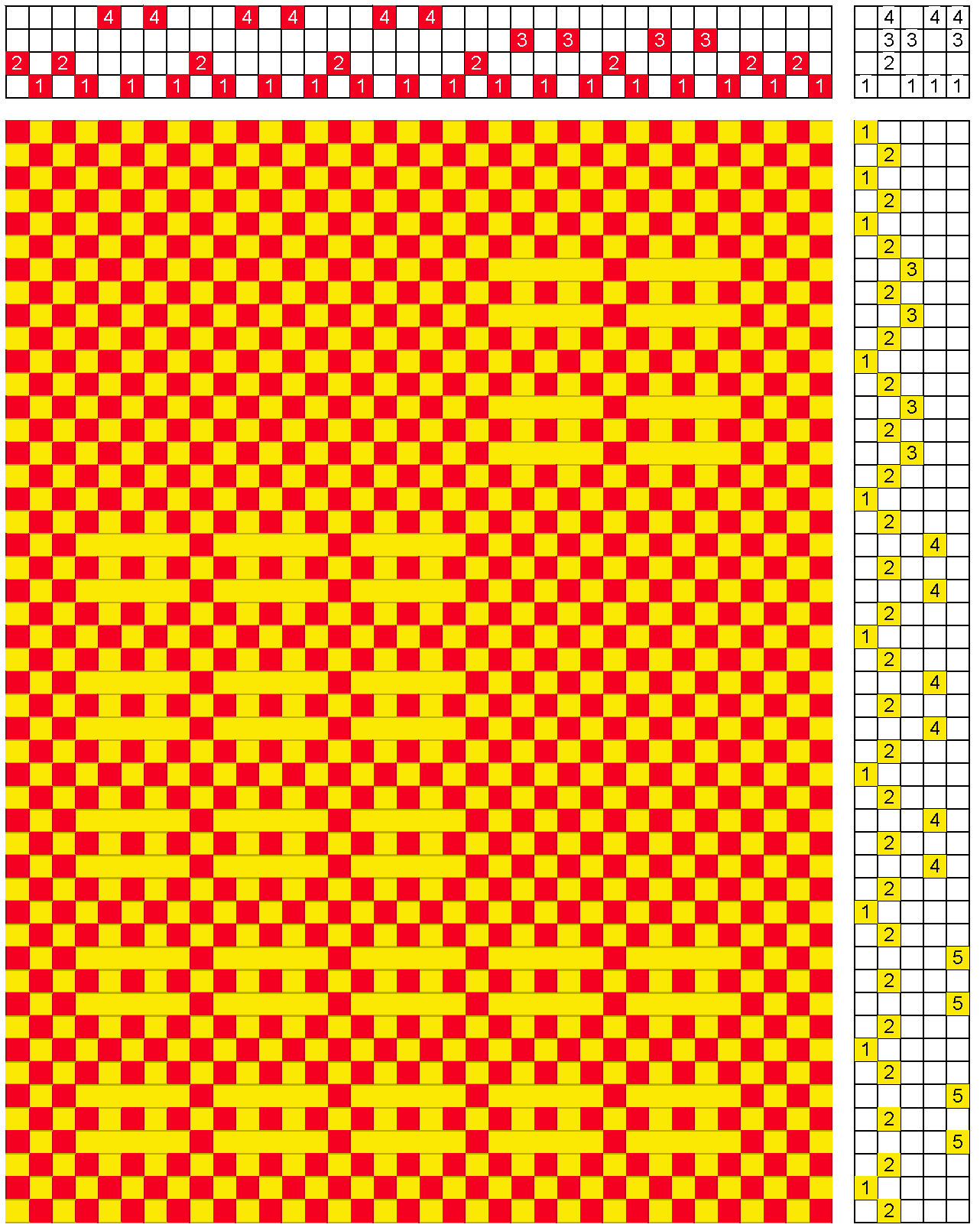
Blocks can be combined in the treadling, shown at the bottom of the drawdown. But to repeat blocks they have to be separated by shaft 2, while in summer and winter the blocks are adjacent.
Once I clarified the classification, I decided to look at the possibilities in a methodical way and see which structures I had not woven yet.
Summer and winter – single, unpaired two-tie, 1:1 – is the simplest of unit weaves and can be woven on four shafts. If we look at the nomenclature, we know we couldn’t have blocks with less than a single shaft! But from the above discussion about the difference between tied unit weaves and unit weaves in general, we know that we need at least two ties for a structure to have fixed blocks.
The next logical step to me was to change the other parameter: single, with two paired ties. I didn’t find that option where I looked, certainly not an exhaustive search, but it is easy enough to determine what it should be.
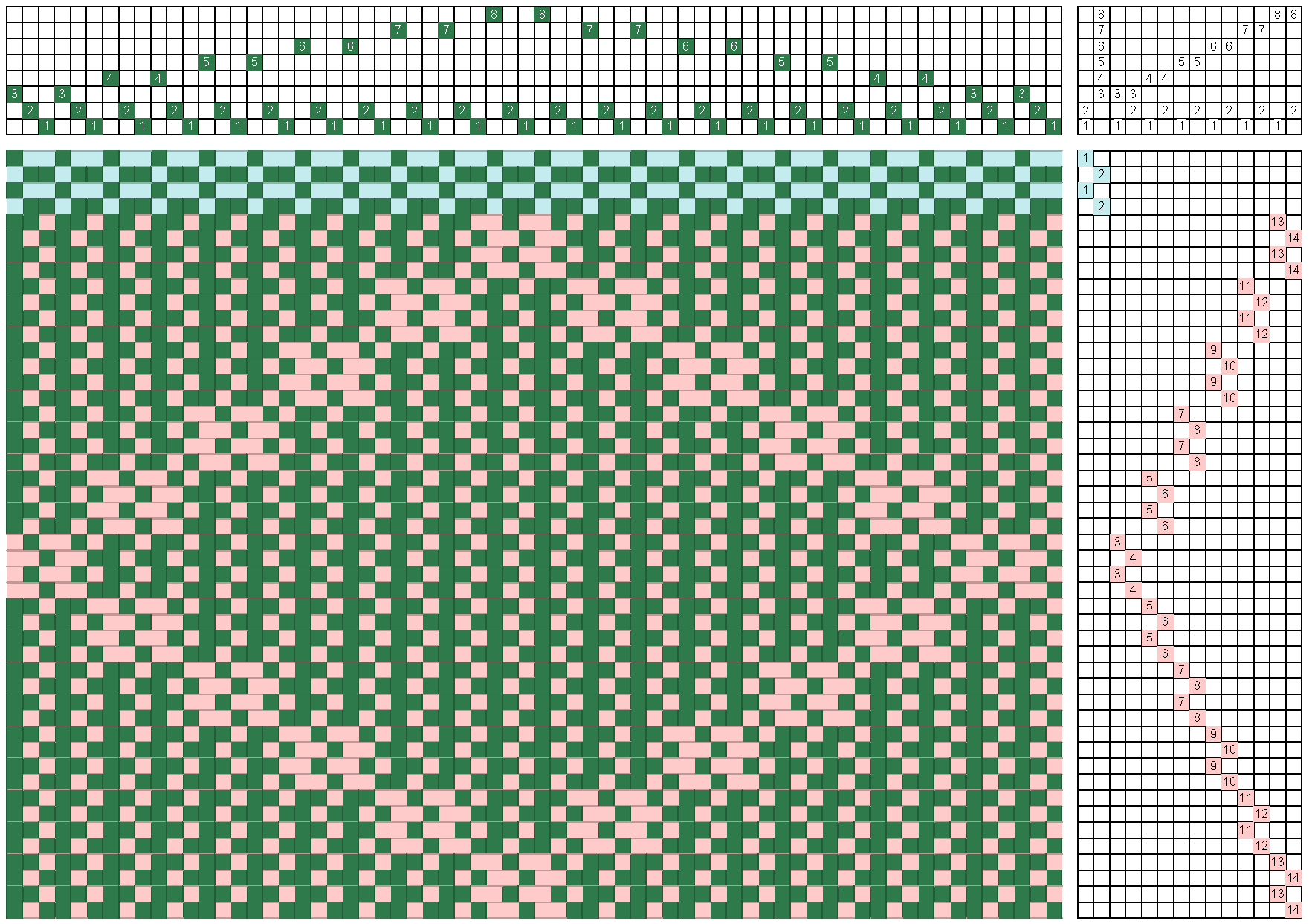
The ratio is 1 pattern thread for 2 two ties, so the structure is: single, two-ties, paired, 2:1 ratio.
Because the block is small, I doubled each one for my sample; I threaded the 6 blocks in pointed order and wove diamonds as shown in the drawdown.
For the treadling, I added a pattern shaft to each tie and treadled the blocks in that order, as shown in the draft. This is a common way to weave tied unit weaves.
As with all other tied weaves, a ground thread alternates with the pattern thread. The top of the drawdown shows the treadling steps for the ground, which is not plain weave, but a pseudo basket weave. This is not unusual, other tied weaves have grounds that are not tabby.
Here is the front of the sample, green warp and ground weft, off-white pattern weft:

And here is the back:

As written in the draft, the treadling requires 14 treadles, but I wove it on a loom with 10 treadles using two feet. The ground required 2 treadles, the tie down shafts 2 more, and the pattern blocks 6. My loom is also a rising shed, so in order to weave each block, I had to raise all other shafts, that is, to weave block A which uses shaft 3 in the threading, I had to lift all pattern shafts but 3. Below is the actual drawdown for my sample.
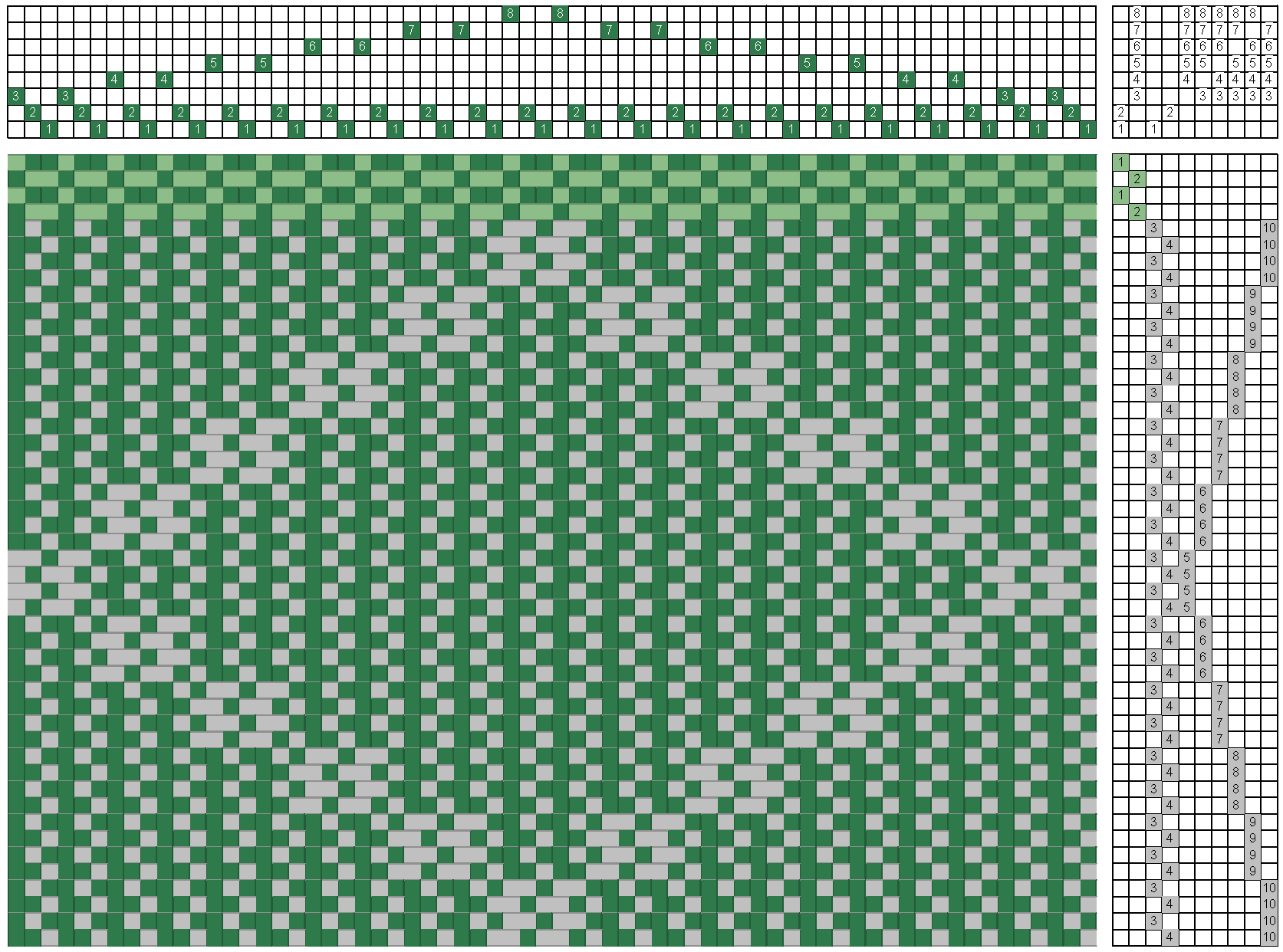
The possibilities for tie weaves are many: more than one pattern shaft, more than two ties, and once we increase either number, there are a variety of ways that the shafts can be arranged. For example, the tie unit weave called Bergman –single, three tie, unpaired, 1:1 – uses 3 ties, arranged in a 3-shaft birds’s eye twill, while another by the same nomenclature, uses a pointed twill.
If you want to learn more, come to my seminar at Convergence®, I would love to see you there!
Happy weaving!
Marcy
